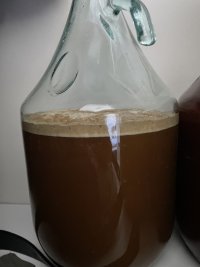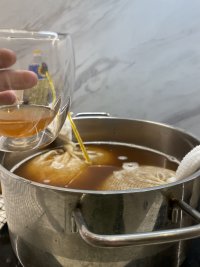Hello guys, a newbie home brewer here!
I started making wines/meads 2 years ago and just recently decided to brew a beer.
Since I am from Lithuania, its a bit hard for me to get all the information in my native language so I spend most of my time in HBT forums.
I tried to make a 4L (~1gal) batch just to see if the recipe I made up would work
I used ~0.9kg of malt:
30% BEST A-XL barley malt
60% Munich Dark
10% Caramell Munich III
I tried to mash everything at 65-67C for 1 hour. (I don’t have any fancy equipment so I just used my 7L stock pot (yes, I sanitized everything))
Then I boiled the wort for 1 more hour, added 4g of Hallertau Mittelfruh hops at 1 hour mark, following by 4 more grams at 20 minute mark, together with some sliced ginger root.
Cooled the wort, pitched the yeast and now its happily fermenting in my cupboard at room temp. (After 12 hours I can see fast bubbling and some krausen)
The main problem is my beer knowledge, I know that I like dark lagger with a hint of caramel, but I have no idea what it is made of. As I said, I completely made up this recipe with my limited knowledge and I wanted to ask if its even close to dark lager?
What specific does the beer has to have to be called a “Lager”??!
Another question…
My starting gravity was 1.039 at room temp. Seems a bit low… Is it because my mashing efficiency was too low? Or should I just use more grains?
*Sorry for any grammar mistakes, English is not my native language…
Also is it ok to mix wheat ant barley malts? I tried to brew a light beer today and used 50/50 wheat ant barley malts - was it a good idea?
I started making wines/meads 2 years ago and just recently decided to brew a beer.
Since I am from Lithuania, its a bit hard for me to get all the information in my native language so I spend most of my time in HBT forums.
I tried to make a 4L (~1gal) batch just to see if the recipe I made up would work
I used ~0.9kg of malt:
30% BEST A-XL barley malt
60% Munich Dark
10% Caramell Munich III
I tried to mash everything at 65-67C for 1 hour. (I don’t have any fancy equipment so I just used my 7L stock pot (yes, I sanitized everything))
Then I boiled the wort for 1 more hour, added 4g of Hallertau Mittelfruh hops at 1 hour mark, following by 4 more grams at 20 minute mark, together with some sliced ginger root.
Cooled the wort, pitched the yeast and now its happily fermenting in my cupboard at room temp. (After 12 hours I can see fast bubbling and some krausen)
The main problem is my beer knowledge, I know that I like dark lagger with a hint of caramel, but I have no idea what it is made of. As I said, I completely made up this recipe with my limited knowledge and I wanted to ask if its even close to dark lager?
What specific does the beer has to have to be called a “Lager”??!
Another question…
My starting gravity was 1.039 at room temp. Seems a bit low… Is it because my mashing efficiency was too low? Or should I just use more grains?
*Sorry for any grammar mistakes, English is not my native language…
Also is it ok to mix wheat ant barley malts? I tried to brew a light beer today and used 50/50 wheat ant barley malts - was it a good idea?
Attachments
Last edited:




